by Tom Watson.
 |
|
Tish Ciravolo |
Tish Ciravolo is well known in the music world not because she’s recorded great guitar instrumentals but because she’s been instrumental in creating great guitars for an underserved segment of the guitar buying market: women. Ciravolo claims that in the year 2000, female buyers accounted for only 5% of total new guitar sales and the odds are she’s done her homework. Tish Ciravolo is the founder and president of Daisy Rock Guitars, “The Girl Guitar Company”.
2000 was a landmark year for Ciravolo. It’s the year Daisy Rock Guitars was established. What triggered the company’s birth is becoming a music gear industry legend. Her daughter Nicole, who was a one-and-a-half year old, draws a daisy. Mom adds a guitar neck to the flower and inspiration strikes. She shows the drawing to her husband, who is the president of Schecter Guitar Research, and asks a simple question: why not? Let’s make a line of guitars that encourages and inspires young girls to learn how to play.
Since the year 2000, Ciravolo’s turn of the century dream has become a successful business. She claims that sales have doubled every year and that women now account for 10% of the guitar buying market. In 2006, the Daisy Rock prototype was inducted into the Museum of Making Music and at the 2007 Winter NAMM Show Daisy Rock unveiled its first “made in USA” model, a coming of age event for a US-based guitar maker.
Ciravolo has graced the pages of Time, Newsweek, and People magazines, but the fairy tale-tinged Daisy Rock story is far from a happily-ever-after ending. The dragon still breaths fire.
The phrase “the year 2000” has a contemporary ring to it, very New Millennium-ish. On New Year’s Eve 1999 we sat in front of televisions watching feel good century-at-a-glance pieces and took comfort in the progress made in the 20th century toward the elimination of discrimination based on race, color, national origin, religion or gender. After all, by the time the New Millennium rolled around, Old Millennium landmarks like the 1963 Equal Pay Act and Title VII of the 1964 Civil Rights Act had had close to 40 years to work their magic in the United States. If women now chose not to pursue certain career paths, surely it was simply that – a matter of choice.
Unfortunately, that’s a New Year’s Eve prime time and champagne point of view. Here’s what the United Nations Population Fund (UNFPA) had to say about the dawn of the New Millennium in its summary of a report titled The State of World Population 2000:
Despite the tremendous changes of the 20th century, discrimination and violence against women and girls remain firmly rooted in cultures around the world. Passed down from one generation to the next, ideas about ‘real men’ and ‘a woman’s place’ are instilled at an early age and are difficult to change.
It’s a frank reminder about the reality of equality and the dream of a level playing field: You can legislate sound laws but not sound thinking.
The important word in the UNFPA statement is ideas. Ideas give birth to an ideology and it’s the pervasive ideology of what are and are not proper gender roles that constitutes the major hurdle women face today in many arenas, including serious guitar playing.
I climb the soapbox for a reason: Daisy Rock Guitars are cute. That’s especially true of the models designed with pre-teen girls in mind. But, don’t confuse cute with frivolous. These cute guitars are one woman’s (company’s) serious attack on a male ideology that attempts to dictate what girls should and should not do, what they should and should not like, and what guitars and guitar playing should and should not be.
Watch music videos: you’ll see more women dancing in the background than playing guitar solos up front. Read guitar magazines: you’ll see more women selling instruments to men through sex appeal than giving in-depth interviews. The message is that a woman’s role is to be with the band, not in the band.
This ideology is the dragon Tish Ciravolo wants to slay. Cute is one of her weapons.
Daisy Rock guitars are an invitation to fun. They deliver the message that guitar playing isn’t Eric Clapton, Stevie Ray Vaughan, or Slash. Daisy Rock guitars tell women of all ages that guitar playing isn’t about sounding, acting, or looking a certain way, it’s about sounding, acting and looking your way.
But, the underlying Daisy Rock message is aimed at both women and men: An ideology and the resulting status quo that marginalizes, isolates or inhibits women from the joy of making music is neither right nor acceptable and must change. Tish Ciravolo’s goal is to win share of both minds and market.
The conversation below took place on December 1, 2006.
__
Tom Watson: I know the basic Daisy Rock story. What I’m interested in is what took place from that moment of inspiration to when the first Daisy Rock guitar ships. How you made the Daisy Rock idea a reality.
Tish Ciravolo: That’s something I don’t get asked a lot of questions about. It’s always about what’s happened since. But, yes, I can give you the business story and the timeline that goes with it, if that’s what you’re looking for.
Tom: Let’s do it.
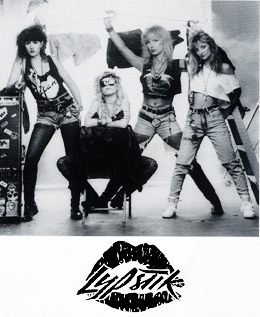 |
|
Tish Ciravolo (left) with Lypstick |
Tish: If you’re familiar with my bio, you’ll read in there that I played in a lot of bands in the ’80s. I played predominantly bass guitar and I had an interesting experience the first time I went to a music store to buy a bass. The salesman says to me, “What do you mean you want to get a bass guitar for a girl?” Then he sells me a very obnoxious, huge, heavy bass that starts with an “F” that I won’t name, respectfully. I took it back the next day and said, “Either I’m really crazy, or I just can’t play this.” I’m a big girl.
I’m not like a very petite, small, 5’1″ woman. I’m 5’8″, and I’ve always been this statuesque kind of female. So, I thought it was really odd that I still couldn’t play this piece of wood that I had bought the day before. I immediately traded that first bass in for a Yamaha BX-1 bass, which is like a Steinberger headless, with a very thin neck. It hadn’t dawned on me at that stage in my life that there ought to be another option out there because hardly any girls in the ’80s played.
I went through that whole metamorphosis, as every musician does, of playing in a lot of different bands, writing a lot of different music with a lot of different people, and trying to secure the ultimate record deal. It didn’t happen. I did a lot of really fun things, but I just didn’t get to that stage. Some people make it, some people don’t, and I didn’t. I’d always said I wanted to have kids, so, at about the age of 34, with that biological clock of mine ticking really loudly, I put the bass guitar down, stopped being in a band, and said, “I’m going to get pregnant and have a baby,” which I did. My husband [Michael Ciravolo] was on tour at that time. He had worked at Sunset Custom Guitars.
They had closed and he had just started taking over Schecter Guitar Research, but it was still in the gray area as to whether or not Schecter Guitars was going to survive.
Tom: Schecter was making guitar replacement parts wasn’t it?
Tish: Yes. This is 1995, 1996. He had started working for Mr. Shipley in 1994. ’96 was when the whole Schecter thing started taking off. Before Michael became president of Schecter, a fellow named Dave Hill ran Schecter Guitars and he had a couple of artists that he dealt with but, basically, it was a parts company run out of a closet behind Sunset Custom Guitars on Sunset Boulevard. It had a bigger persona than that, but that’s essentially the…
Tom: Reality.
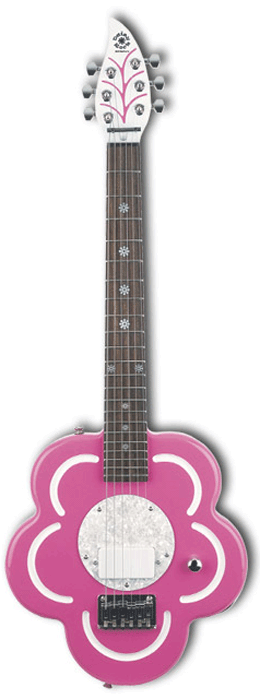 |
|
The Short-Scale Daisy |
Tish: Yes. Mike ran Sunset Custom Guitars, Sunset Custom Shop, and behind that was the Schecter Guitar Company. So, Dave Hill ended up leaving the position, and Mr. Shipley offered the position to Michael, who was touring with the band called Gene Loves Jezebel as a guitar player. This was a big reunion tour. He didn’t play in the original band in the ’80s. This was the new band that the two brothers put together and went out and toured with.
So, he’s touring and I’m working a day job at A&M Records. I said, “You know what? I’m having a baby. It’s that time.” I got pregnant and we had a little girl. What happens when you have your first child, what every female feels, is, “I want to stay home with my kids. I don’t want to get up and work every day after she’s six-weeks-old and hand her over to a complete stranger.” So, when I had Nicole I started working for Schecter doing some part-time financial things and stuffing envelopes, sending out catalogues, filling in for the sales guy when he was out. It was, just, whatever needed to be done, we did. Mike was running the company and only had three people working for him.
Tom: You’ve seen the birth of both Schecter Guitar Research and Daisy Rock.
Tish: Right. So, I’m there with Michael. He’s always been in retail. Since he was a teenager, he’s worked at retail music stores that sold guitars and he’s an amazing guitar player. He knows the business inside and out. And now I’m working at a guitar company with him that he’s running, and he’s turning a $100,000 a year guitar company into this multimillion dollar business. This year they closed at, I think, over $17 million.
But, back then, it was nothing. It was just parts. Then he hired Marc LaCorte and they decide to try to put together the first 7-string to come over from Korea. I watched them go through this process. I don’t know anything about it. I just consume it, if you know what I mean. I’m watching and learning. I know nothing about what it means because I don’t play guitar predominantly and I’ve not been around guitars my whole life. I just played bass in guitar bands. All of a sudden, I’m watching a one of the industry’s top luthiers build guitars out of pieces of wood and Mike’s got the top set-up guy in the business. They came from Mr. Shibuya’s [Hisatake Shibuya] shop to work with Schecter.
 |
|
Red Hot Red Heartbreaker |
Mike’s got these two extremely talented craftsmen and he’s got Marc LaCorte who knows a lot about the music business, and they decide they’re going to conquer the world with this new type of Schecter guitar. And they do it. They do it with a 7-string, which is an amazing process for me to watch. I have a baby. I’m there helping and watching, and now I’m kind of getting a feel for what it takes.
I’m watching him deal with a lot of different buyers from a lot of different dealers, and it’s a good old boys’ network. The guitar business has always been a good old boys network, men who’ve been in the business for 20 or 30 years, from “back when Leo Fender did this” and “before CBS bought them” and “when Gibson was that”. I’m just absorbing it all while I’m there.
When Nicole’s about a year old I got pregnant with my second daughter. Mike and I were sitting at home one day and Nicole and I were drawing. She drew this daisy and I thought, “Oh, this is beautiful.” I added what I thought was a guitar neck with a lead guitar headstock stuck on the end of it. I was looking at this drawing, and I said, “You know what? It would be so great if when our daughters grow up they can walk into a music store and have a completely different experience than what I had. It would be great if they could walk into a guitar store and have a salesman treat them like they were a normal part of the guitar community.” This whole thing came from me walking into the music stores and guys going, “What band’s your boyfriend in? What management company are you here to pick up for?” It was never, “Hey, do you play?” And I was in Hollywood. I’m in the most progressive city in the United States.
Mike and I started talking about this and we said, “Well, let’s make a guitar that inspires really young girls to learn how to play. Let’s make it okay for a young girl to play guitar.” What if we could get society to look at a young girl playing guitar the same way it looks at a young girl learning piano, flute, or learning clarinet? What if we could change that concept? The only way you can do that is to put this guitar out into stores. It would be really great if you put it in the hands of celebrities. It would be really great if you did all these other things that go beyond that, but I recognized right at the beginning that it has to be in the stores, it has to be available at the retail level.
So, we went forward with, “Let’s make this cute little daisy guitar.” It goes to the luthier and it’s him working on the guitar’s body with me from this drawing. We put a neck on it. We designed the headstock, got all the electronics into it, made sure it wasn’t too heavy, made sure that the neck was slim enough, made sure it looked like a daisy and not a cloud. There was so much production that went into it.
Tom: How long did the prototyping process take?
Tish: It was at least six months getting it to the point where we sent it off to the Schecter factory in Korea and got our first prototype made.
Tom: Who did the mock-up?
Tish: The Schecter luthier, Michael, and I did. We built it at the Schecter Custom Shop and then we sent it to the factory to be duplicated.
Tom: Did you do market research?
Tish: First, we had to get one made by the factory to see if it made sense. There was a lot of this “what-if” kind of thing going on, like, “What are we going to call it?” “I know, let’s call it Daisy Rock.” So, when we got the guitar back from the factory, we just had friends come and look at it. I’m talking about friends of mine that were girls that played and friends of my husband and bands that played in the business. We really wondered what they were going to think. We thought it was really cool, but we had no idea what everybody else would think.
People started coming over to our house to see it and they would say, “Oh, my God. Do you do that in a bigger scale because I’d love to play that if it was a full-scale guitar,” or, “If that was a bass, I’d definitely play one.” I had 30-something-year-old women going, “You know, if I could get this in a bass, I’d be playing it tomorrow night.” I thought, “Okay, we did something right!” All of a sudden, it became really evident to us that, yeah, we nailed it.
And that’s exactly how it started. I mean, if our friends would have come over and gone, “What are you doing?” there would have been a lot of reconsidering. But, Mike and I never looked at Daisy Rock like, “Okay, here’s our ticket. We’re going to buy a house off of the money this is going to make.” It was solely, “Let’s help our kids have a different concept about women and guitars and music than what I grew up with.”
Tom: Seems that sooner or later somebody was bound to realize that the female guitar market could be huge and take a hardcore business attitude about it. But that’s not what happened, is it?
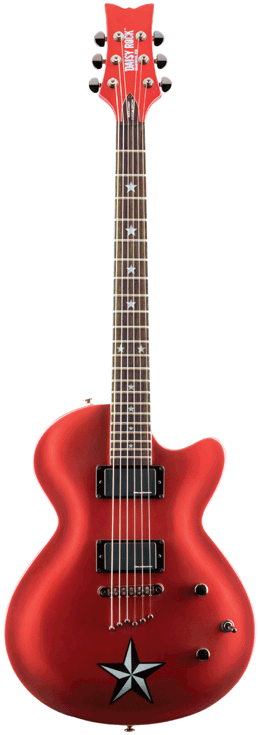 |
|
Rock Candy with Red Star Finish |
Tish: No, and I don’t know if that’s happened yet. We’re still living in a society where women are often overlooked. I had seen Leather Tuscadero, who was Suzi Quatro, in 1975 or ’76 or something, when I was a teenager. And that’s what inspired me to play. I saw this girl and thought, “Oh, my gosh. She totally rules. I have to do what she’s doing. That’s the coolest thing I’ve ever seen on television.” That’s why I learned to play, because I saw it and identified with it. There was a woman doing it. She looked really cool doing playing and that made me want to do it too.
Remember the Go-Gos, on Saturday Night Live? That was the first time I’d ever seen a girl play live anywhere. It just wasn’t around. The Runaways had played, but they were kind of before my time. I knew who Joan Jett was but I never figured I would go see her because she was in a guy band and as a teenager, I didn’t connect the dots. I’m living in L.A. and there are only two really famous girl bands out there playing, The Go-Gos and the Bangles. There were like five unsigned girl bands in L.A. and we’re all trying to make record deals. That was back when they said if you were a girl in a band and you played or if you could even halfway play, you would definitely get signed because nobody did it. Well, maybe nobody was doing it but that didn’t mean the few who did would get signed.
But, by 2000, the year I start Daisy Rock Guitars, you can turn on the Disney Channel and there are shows based around girls that go to school and come home and play music and guitars about what the guys said to them at their lockers. There’s Miley Cyrus from Hannah Montana. She sings a song on the show about her mother who’s died and she goes out on the patio and picks up her acoustic Daisy Rock guitar and writes a song to her mother. There are all of these imprints that you now see in the media. We did a Cinnamon Toast Crunch commercial with a girl playing guitar, jumping up and down playing guitar. There was a Gap commercial a few years ago that had a girl jumping up and down on a trampoline in her Gap sweater playing a guitar. It’s the imprinting. It’s the changing-of-society thing that I’ve been on this bandwagon about, saying that if you can show an 8-10-year-old girl that this is a cool thing to do, they will be inspired to do it. And, if you can convince the parent that this is an okay thing to do, that this is going to make them just as intelligent and artistic as the piano or the clarinet, then they’ll buy it. So, it’s like I’m connecting dots all the time for them.
Did I answer your question? [Laughs]
Tom: I think so. Market research was done in your living room.
Tish: Right. And, I had this wonderful woman that I was friends with at the time, she was the wife of one of Mike’s artists, Tyler Bates. He’s a very famous composer now. His wife owned a PR company and she sat me down and said, “Okay. If you want to do this, this is how it’s done. You’ve got to put together a media press kit, send it out, and see if anybody cares.”
So, I sat down and put together a media press kit and did a one-sheet for the Daisy Rock acoustics and a one-sheet for the Daisy Rock electrics. We had six guitars in the lineup. I put some really silly stuff in there that said, “If you’re a girl, you should play a girl guitar because it’ll make you really cool, and it’ll make all the guys want to talk to you at the mall.” I tried to put everything in there I could think of because it had just never been done before.
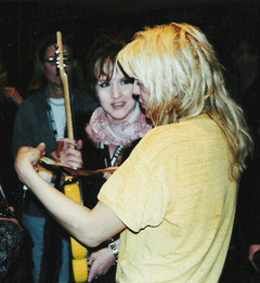 |
|
Courtney Love signs Daisy Rock Prototype |
We sent it out. We sent it to Teen magazine and ROCKRGRL magazine and Jane magazine, and just anybody to see what they would do with it, and one person called me. That was Jane Forte from Teen. She said, “I just got your press package. It’s the coolest thing I’ve ever seen. Can you bring your guitars over? We’ve got a photo session for the prom models for 2001 and we want to use your guitars in the shoot.” That was the first call.
The second call I got was from Carla DeSantis of ROCKRGRL. She said, “I’m getting ready to do this event called the ROCKRGRL Conference and I think you should have your guitars there. This is the coolest thing I’ve ever seen.” So, I went and met Courtney Love at the ROCKRGRL Conference. I got her to sign my very first prototype, the one that just got inducted into the Museum of Making Music, which you guys ran a story on. That’s how the media kit worked out.
Tom: At that point, 2000-2001, how big is the Daisy Rock company?
Tish: [Laughs] We okay the prototypes and get our first 300 guitars in. The first company that picked me up for sales was Musician’s Friend because we had a friend over there and Mike called in a favor. They put the guitars up and all of a sudden we sold 80. I spent my Christmas Eve packing the first Daisy Rock guitars. I set up 80 of them, packed them, shipped them out and got them to all these girls for Christmas. That was my first Daisy Rock Christmas.
Tom: What year was this?
Tish: That was in the year 2000. I did the drawing in February, we get the proto done in May, we got it over to the factory and got it back in September. I did the Rocker Girl Conference in November. We finally got guitars in December. We sold 80 of them, and I set them up then packed and shipped them all myself.
That was the first year. The second year, it was just like one thing after another kept hitting. I did my first NAMM show in January of 2001. I had a little 3’x3’ in the back of the Schecter booth. People came over and they were, like, “Well what’s this? What’s this? Oh, my God, this is the coolest thing.” One person I met that was really great to me at that show was a fellow named Hap Kuffner [Kuffner International, Inc.] who is now my export agent. He said, “Hey, if you want to get these done, darlin’, you’ve got to stop getting them out of Korea. You’ll never make any money. We’ve got to get them from China.” He’s helped me ever since.
Tom: At this point, Daisy Rock is basically you.
Tish: Oh, yeah. I’m still at Schecter. I had my second daughter, Sophia, in March of 2000, so she was in the Schecter offices with me. Now, Nicole’s off to preschool and Sophia is coming to work – I had her at work with me six days after she was born because Schecter is still Mark, Mike, J.P., the two set-up guys, the shipping guy, and me and we’re still trying to build the Schecter brand. They’re doing their thing and on top of that I’m doing this little girl guitar company at the same time.
We kept that up until 2001, and then it got to be like, you can’t work 18 hours a day and raise two kids. It’s just not fair to somebody. So, we got an accounting person at Schecter who took over because I was running accounts receivables and accounts payables and all that kind of stuff. We got somebody in to help me do that so I could limit my time for Schecter and start spending more time on Daisy Rock. I kind of weeded out the Schecter job over the course of two years. It finally got to the point where there was no time for me to do the Schecter work.
Getting back to when you were talking about market research, there was a lot of just looking at the guitar magazines going, “I cannot be the only one offended by these ads.” You know, selling guitars with images of “sexy” girls. I understand the dynamic to it, but I also understand, as a female musician, that there’s nothing that speaks to me in any of these magazines. They weren’t marketing anything to me. It’s all geared towards guys who’re going to buy a guitar, guys who are going to buy a strap, or guys who’re going to buy a pedal. There’s nothing that says pink and flowery and girly. I was like, you know what? This is so not fair. We need guitars. We need straps. We need pedals.
Now, if you look around, I think we’ve influenced the marketplace.
Tom: I’m surprised that there hasn’t been more of a competitive response.
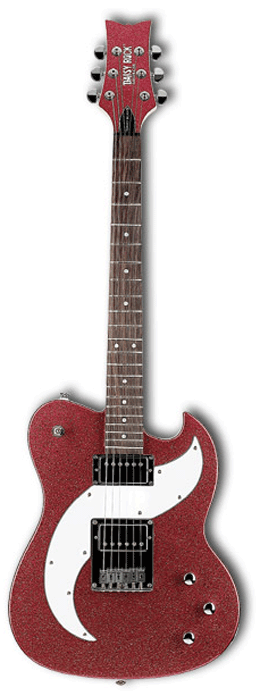 |
|
Tom Boy Deuce |
Tish: It’s very funny. In 2002, I’m at the Summer NAMM show. I have a 10-foot booth of my own. I walk over to the Fender booth with Hap Kuffner because he thinks Daisy Rock should do a box set [guitar and amp package] and he wants to show me the Fender box sets as an example. I’m in there five minutes and this guy comes up to me and gets introduced as the director of marketing or head of marketing for Fender or something like that, and he just starts screaming at me. It’s not even like a “hello, it’s nice to meet you.” He starts at the top of his lungs and his voice gets louder and louder and his face gets redder and redder. He’s, like, “How dare you come into this industry and how dare you say no one’s ever done guitars for girls, and how dare you show up at this trade show and who do you think you are?”
I had just been in People magazine a month before and that’s what he was relating to. It got to the point where somebody had to break it up and I had to be walked out of the booth because I started yelling back, “Listen, if you guys know how to do a girl guitar, why didn’t you do one 20 years ago? Because you didn’t think it was worth any money. If you want to know how to do a girl guitar, why don’t you hire me because I’m a girl? No, you’re going to get five guys in business suits that are going to tell you how to make a girl guitar.” I mean, it just got really ugly and I was escorted out.
The story spreads through the show and grows. By the time Sunday rolled around, people were coming to my booth going, “I can’t believe that guy came up and hit you. How can he treat you like that?” I was, like, “Okay, wait a second. That’s not what happened.” But I had obviously struck a nerve and I thought, that’s it, they’re going to come after me. Everybody is going to open up the Pandora’s box and figure it [making guitars with female players in mind] out. And I thought, the shame of it will be, and this is what I have seen, that they won’t have a girl’s point of view on it. It’ll be a couple of guys who are presidents of some guitar company melt it down and go, “Okay. How do we go after this market? Well, let’s just make it pink.” And that’s what happened.
Tom: Takes more than just a feminine finish.
Tish: That’s what we’ve thought from the very first Daisy. I mean, Mike, being a great guitar player, said, “You know, the only way this’ll ever work is if guys pick up a Daisy Rock and it just blows them away.” And that’s been the motto since day one. I’ve never had a guy pick up our guitar, start playing it, and not go, “Oh, my gosh. Okay. I get it. This is a great sounding, playing, feeling guitar.” That’s why we have Robert Smith from The Cure and Adam Levy from Norah Jones, and Paul Leary from the Butthole Surfers. We have these guys that find us and go, “I love your guitars. Even though they’re for girls, can we play them?” So, we came out with a shirt that said, “Are you man enough?”
Tom: A lot of male players have small hands too.
 |
|
Rock Candy Bass |
Tish: Right. That was part of the concept behind the Daisy model and then the Heart. It’s not just for girls. It’s a slimmer neck profile, it’s lighter in weight, it looks really cool, and that’s going to hit everybody. Even though we are about whatever it takes to get more females to play guitar and play music, sometimes maybe girls get into music because their boyfriend plays too. Maybe it’s him standing there going, “You know, this is a great guitar.” Every girl I know who has a boyfriend that plays guitar ends up going to a music store with him to hang out. It’s one of those relationship-building moments and I want to get the message to girls from any side I can. I want the guys to love it. I want the girls to love it. I want younger girls to love it. One of our biggest demographics is grandparents. We’re the official guitar for the Grandmother’s Cool Rock Club. [Laughs] Who knew?
But you know, what you’re saying about competition is right. One of the very first companies that came after us took an acoustic guitar, painted it pink, and called it a girl guitar. They didn’t care about the neck or the weight. And the Fender Hello Kitty, I totally get what they’re doing. God love them, they can afford that license fee, because I know we couldn’t. A lot of people said to me, “You should be really offended by this. You should be really upset.” And I said, ” I understand why I should be, but there’s another part of me that thinks, okay, they’re just going to get more girls to play guitar. Then, when a girl learns how to play guitar or is in the guitar community, they’re all going to say the same thing to her, like, you’ve got to get a Daisy Rock.” So, somewhere along the line it does help us. No one’s going to be, like, “Oh, you’re a girl guitar player so should get a Gibson.” We’re the premier girl guitar company.
Tom: One of the things that’s intrigued me about the Daisy Rock story is how the website has always had the look and feel of a big company.
Tish: That’s great. I love that. It’s not, but you know, we have a great underground current of girls that are part of this community now. It’s what I was talking about – six years ago there was nothing out there and now there are so many things that will inspire a girl to play guitar and when they get into the guitar community, they find us. So, I try to give this “be part of my club” feeling on our website. It does come off to me like we have a lot of product for the small company that we are, but I’m also going along with the Schecter dynamic. I built my business model after the Schecter business model, and that’s kind of how they did it. They blew up and became huge because they presented themselves that way.
Tom: You’ve done it very well. Look at your news area. Good grief, I can’t believe how many news items are on there.
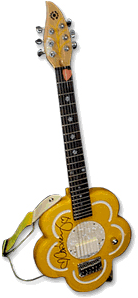 |
|
The Daisy Rock Prototype |
Tish: It’s a PR machine that’s been a blessing. You have to understand how it works. For instance, a Newsweek writer called me and I totally pitched him on what my company did. He said, “Well, that’s nice, but have you gotten any guys to play them?” And I was, like, “Yeah, Robert Smith from The Cure.” He goes, “Oh, my God. I love Robert Smith,” and I said, “Well, he’ll talk to you. He’ll tell you what a great guitar company we are.”
So, he got an interview with Robert Smith and ran a story that Time magazine saw and they contacted me. Then People magazine saw the Time article and they contacted me. It was like a snowball thing. And we’ve done that in six years. We’ve had a couple of those newsworthy moments, like getting inducted into the Museum of Making Music. We got a lot of press about that. That, to me, has been the ultimate honor, I have to say. I kind of walked away from that going, I don’t think there’s anyplace else to go. This seems to be the height. I cried.
Tom: I don’t think there’s anybody in the guitar business that doesn’t know Daisy Rock.
Tish: I don’t think there is either. As far as the guitar industry goes, it’s a phenomenal thing that’s happened. We’ve been embraced. And I love that. I love that it’s been accepted. Sometimes I think it could’ve just been my worst nightmare.
Tom: How big is Daisy Rock today?
Tish: Oh, okay. [Counts slowly] One, two, three, four, five, six, seven, eight … [Laughs]
Tom: [Laughs] Well, I don’t know who designed your website, Tish, but they’re great. They gave you a huge look.
Tish: Yes. That’s my friend, Dee. She has her own website company [Formula, Inc.]. She’s the one that designed my very first site, so she’s designed it from day one. She’s awesome, and if she can get any jobs out of this interview, God love her, because she deserves the work. She’s a great person to work with and does excellent design.
Then, when I moved over to Alfred [Publishing] back in 2003, it just blew the company up because all of a sudden I had a lot of people helping me. They weren’t my full-time employees, so I just had to pay a fraction of their salary. I get a lot of bang for my buck that way.
Tom: Let’s talk about Alfred. Did Alfred buy Daisy Rock or what’s the relationship?
Tish: No, they didn’t buy it outright. They distribute it and they’re partners with me.
Tom: Are you housed together?
Tish: Yes. I’m with Alfred Publishing in Van Nuys, California. I’m in part of the space that they rent out. So, we have the Daisy Rock suites, basically.
Tom: The guitars are manufactured in China?
Tish: China and Indonesia. Then we have a 100,000 square foot warehouse in upstate New York that has its own office and staff. Daisy Rock uses 10,000 square feet of the warehouse space and I have three set-up guys and a shipping guy that work for me there that do nothing but Daisy Rock 24/7.
Tom: Have you thought about a Daisy Rock custom shop?
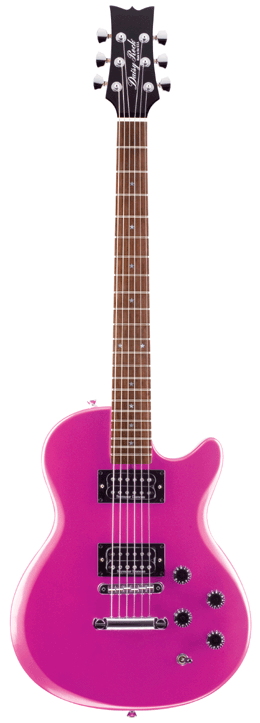 |
|
US Made Pink Label Rock Candy |
Tish: Well, funny you should ask that because in 2007 we’re coming out with our first USA-made Daisy Rock guitar. We’re exploring the custom shop avenue to see if that makes sense to us. This was the first step towards doing that. We have the new USA Pink Label coming out that we’re going to debut at Winter NAMM 2007. We’ll see if our audience will accept that part of a girl guitar company.
Tom: Do you receive many inquiries from customers who’d like to have a custom guitar?
Tish: We do. And, then, of course, the coolest thing about being a guitar company is when you can do a US-made model. That’s something that we’ve been striving to do and wanting to do, and now we’re able to do it for next year. I’m waiting to see how everybody accepts it. I think it’s priced very reasonably and it plays really great. A fellow named John Carruthers [of Carruthers Guitars] in Venice, California, helped design the guitar with me, and he’s one of the top luthiers. I’m just trying not to say too much yet, but I’m really excited about it.
Tom: Aren’t many women luthiers, are there.
Tish: No. I think I’ve met one girl who introduced herself to me at NAMM a few years ago and said that that’s what she did. I’ve not heard of many. I know that they teach guitar building at Musician’s Institute, so I’d be curious to see if they have a lot of females or any females actually show up for the class.
Tom: Let’s talk about life before Daisy Rock. When you were born, your mom was 18, and she’s now a lawyer. Is that right?
Tish: That’s true. My mother is a family law specialist in Northern California and is now studying for the Hawaii bar exam because she’s got a second house there. She wants to retire to Hawaii, but my mother is a workaholic, so she’ll never retire.
Tom: Are you close?
Tish: We’re best friends. I was just talking to her the other day. I was, like, “You know, you’ve got to slow down, mom. I thought that retirement meant to stop running your own company.”
Tom: She’s been a role model for you?
Tish: Yes.
Tom: You first learned guitar from your best friend, Barbara.
Tish: Yes, I did. Barbara Haughey. We were in high school together in Merced. Her family was really musical. She was Catholic and had eight brothers and sisters and I was an only child at that time. You’d come to my house, there’d be no noise, nothing going on, and we’d go to her house and it was just massive pandemonium. So, I always wanted to go to her house and hang out. Her older sister played guitar, her mom played banjo, her dad played banjo and piano, and Barbara played guitar, which I thought was the coolest thing. When we saw Suzi Quatro on Happy Days, I was like, “I totally want to do that.” Barbara was like, “It’s really easy,” and she taught me how to play. We’d be sitting in the park and hear a Fleetwood Mac or Heart song and I’d go, “How do you do that?” We played Janis Ian and all those fun songs from the ’70s.
Tom: You toured with a group called Plateau?
Tish: I did. My boyfriend at the time was in the band Plateau and they played Air Force bases in Northern California. He was stationed there. When he got out, we lived together then I ended up singing in the band and running the lights and running the sound stage and sitting in on bass every now and then – just kind of a “whatever needed to be done” thing. It wasn’t like a band that had a girl in it. I was the girl with the band. You know what I’m saying? I was never recognized, because it wasn’t cool.
Tom: You later worked for Jay Leno’s manager.
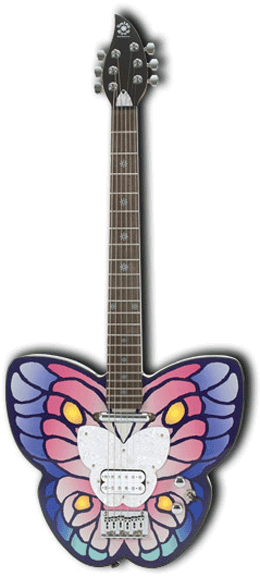 |
|
Butterfly |
Tish: I worked as an assistant to Helen Kushnick. Helen managed Jay Leno and a couple of other people, and I worked for them during the time that Jay did the Tonight Show just on Tuesday nights. Right after I stopped working for her is when he took over the Tonight Show full time. There was a movie made about this called The Late Shift. It was about Jay Leno versus David Letterman and who was going to take over the Tonight Show for Johnny Carson when he retired. I worked for Helen Kushnick during that time period. Kathy Bates plays her in the movie.
Helen was ruthless. That woman taught me more about how to deal with business in the year that I worked for her than you’d ever learn in a school. She had more balls than any female I’d ever met. She taught me that, hey, you’ve got to stand up and say what you believe in and stand behind it and not let guys completely tell you how you’re going to do your life. Her husband, Jerry Kushnick, was a very famous agent that had discovered Jimmy Walker and Jay Leno. Then he passed away. Helen had twins at Cedars-Sinai. One of them was given a transfusion and died of AIDS. Helen passed away a few years ago from cancer. She was a type A personality, a go-getter, a “this is how you do business, don’t let anybody push you around” kind of woman.
Tom: When you were getting Daisy Rock off the ground, were these people still in your network of friends?
Tish: No, no. I wish I could say yes. By then I had stopped working for Helen and you know, you loved her or you hated her, and if you didn’t work for her, she hated you. She was that type. She had a very, very agent-oriented Hollywood type personality. But I learned from it. It taught me…I guess the word moxie comes to mind.
Tom: What about working at the Improv and The Comedy Store?
Tish: Oh, yeah. Those are back in my comedy days when I really thought I could be a stand-up comedian. It didn’t work out so well.
Tom: That took some moxie.
Tish: Well, yeah, but it’s like they say: Every comic wants to be a musician and every musician wants to be a comic. Both think they can do it all, but you really can’t. There are a few out there – Jack Black maybe could be one of them. He’s kind of a famous comic and he’s also in a band. But, there are very few. So, I vacillated a lot between, “Oh, do I want to do comedy? No, you suck at that. Okay. I’m going to go play in a band.” I always played music, but I was always doing other things.
Tom: Tell me about the two independent films, The Wake and Birds & the Bees.
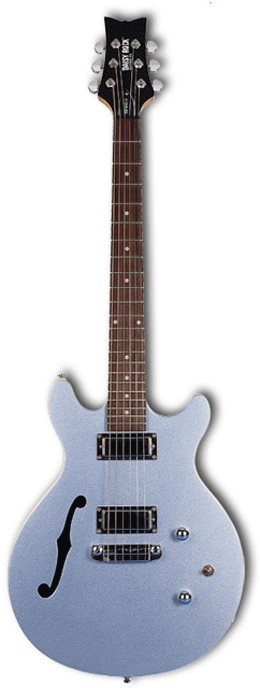 |
|
Stardust Retro-H |
Tish: That’s the first year that I was going to try and be a stay-at-home mom. Then, of course, I can’t do that, because I just can’t sit still. My best friend, Karen Peterson, was a writer and an actress and we decided we’d try to do two independent films and we started writing together. We took a course called The Artist’s Way. I don’t know if you’ve heard of the book, but The Artist’s Way teaches you how to get in contact with your great creator to help you create the things that are within you to create and helps you unblock yourself and let all those things come out. We did this Artist’s Way, and all of a sudden we wrote The Birds & the Bees and we made that a film. Next, we wrote The Wake and we made that a film. Then I started Daisy Rock guitars and I didn’t have time to make any more movies.
Tom: Wait a minute. I’ve worked in the movie business. You don’t just “make a film”. You took the projects from conception to projection?
Tish: We sat down and wrote the scripts. The Birds & the Bees is still in the can. Karen won’t finish it. She doesn’t feel like her acting was what she wanted it to be, so that never got completely finished, which made me angry. Then we did The Wake because I said we’re going to do something that we finish. We got all of these actors and actresses from some acting schools that Karen was in, and we said, “Here’s the dynamic. This is all going to be improv. There are going to be five cameras in the house and I’m going to interview you. The premise is that this is a wake, your psychiatrist’s wake, and the problem with you is that you think that you’re a superhero. Come up with a superhero and come in costume.” From the minute they walked on to the front porch to the minute they left, they were filmed. We took, gosh, I think 12 hours of material and condensed it to this 15-minute film.
Tom: Did you play it at any festivals?
Tish: Yes. It played at the Playhouse West Film Festival. It was groundbreaking and there were a couple of things that happened, but neither one of us was pursuing it like this is our vehicle to try to get something else. It was just something that we wanted to do. I propelled into Daisy Rock Guitars and Karen’s been an actress and done a lot of things since then. She just had a little boy.
Tom: Let’s get back to the guitar business. How do new Daisy Rock models come about now?
Tish: That’s Ron and I. Ron Manus is my business partner. We sit down and start looking at things that interest us and start looking at designs that we think would be really cool as a guitar player or as a bass player.
Tom: Wasn’t Ron Manus a creative director at Alfred Publishing?
Tish: Right. I think now his title is vice president. He and his brother, Steve Manus, own Alfred Publishing. They’re also minority owners of Daisy Rock Guitars. I’m the majority owner of Daisy Rock and run Daisy Rock Guitars. They run Alfred Publishing. But Ron is my business partner and very creative, so we sit down together and we decide, as a team, what we want to do: Do we want to put this model out in this color and charge this much and call it this? You know, we all have our own dynamics that we put into it, and some are better at different things, but he’s like more of my techie guy. He really knows a lot about pickups and all the things that go into the accoutrements of a guitar. I look for design, colors, things that are cool, that hit the cool factor for girls.
Tom: What about your husband, Michael? Is he still active in Daisy Rock?
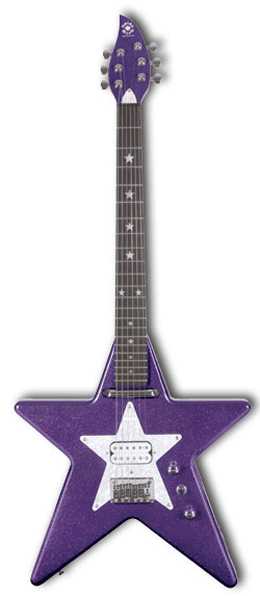 |
|
Star Artist Series |
Tish: Oh, yes, he’s right in there with us. He’s very busy with the Schecter phenomenon and it’s awesome because he’s taken that company and made it this really cool thing. So, we go to him sometimes, and then he’ll come to us with something that he’s thinking about. His focus is Schecter and that’s what he needs to focus on. But, he’s still part of it and he always will be because we’re married. Sometimes at 1:00 in the morning we’re still talking about the guitar business going, “Okay, we gotta stop now.”
Tom: You’ve got to be the first and only husband and wife team to run two different guitar companies.
Tish: I think we might be. I think we might be.
Tom: How many women run guitar companies beside yourself?
Tish: I know there’s a girl at Luna Guitars. I think I’ve met her. She’s told me she’s a big fan of mine. But I don’t know what her dealings with that company are. I just think that she’s part of it. If you’ve seen my website, you know who I am and what I do. It’s really evident. I don’t think there are any females involved with the Fender girl division or the Gibson division. I don’t know. But, from the trades and things that I read, I don’t see anybody there that does what I do.
Tom: You’re also involved in several charitable causes.
Tish: Yes, especially for breast cancer, because you know my girlfriend, Barbara, passed away from breast cancer and we’ve had people here that have been affected by it this year. It’s just something that never goes away, and they’ve never found a cure for it.
And anything kid-oriented. I love to give guitars to the Girl Scouts and anybody we can to promote Daisy Rock Guitars – to just get it into a girl’s hands. That’s what we’re about.
Tom: Is Nicole playing guitar or bass now?
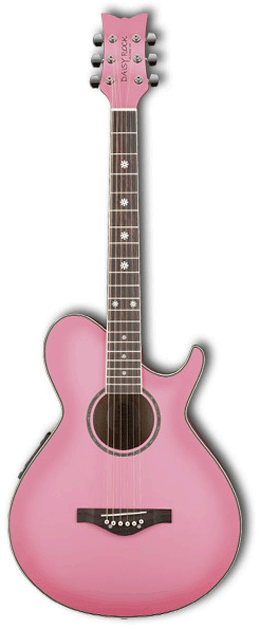 |
|
Wildwood Artist Series |
Tish: She is. She’s eight. She plays guitar. She also wants to be an actress and a singer. I make her take guitar lessons. I had her start last year. She uses a book that I wrote, The Girls Guitar Method: Book One. She can play three barre chords. I tell her it’s just something I want her to try, I don’t say she has to be good at it. My younger daughter is playing piano. I’m waiting until she’s seven so I can get her into guitar lessons. She really wants to do it. I’m saying, “Wait, wait, wait.”
Tom: What’s the plan for Daisy Rock? Do you have a 5-year plan?
Tish: You know, you’re starting to sound like the banks. The plan is world domination. That’s what it is. This year, we were able to get distributors in a couple of other countries and we’re come out with the coolest guitar line we could ever come out with for next year [2007] and the year after that.
Tom: You’re in the UK now, right?
Tish: Right. We have L&A Imports as our distributor and we’re also in Sound Control over there. And then we have Filling Distribution in France, and we’re a part of Yamaha now in Japan. They picked up our guitar line last year. We just went with SF Marketing in Canada this year. So, it’s world domination.
Since I started in 2000, the percentage of girl guitar players has doubled and I want to see that continue. That’s my dream. It was 5%, now it’s 10%, soon it will 15%. Maybe in 10 years I can turn on MTV and see girl bands playing Daisy Rock guitars and know that’s going to inspire a whole new generation of girls.
Tom: What tells you that the number of women involved in guitar playing is growing? What are the barometers or benchmarks?
Tish: That’s a good one, kind of like letting the secrets out of the bag. I think as a mother with two daughters I sense it just from the media that I’m exposed to. Another side of it is knowing what’s missing because I was a musician. I still feel like there’s so much more we have to do. Even though everybody’s amazed by what we’ve done, to me, it’s just the tip of the iceberg. That’s what drives the people that I work with crazy, because I’m always saying, “But, you don’t understand. There’s so much more we have to do.”
Tom: Speaking of that, you don’t make amps do you?
Tish: No, and everybody thinks we should. I always say, “Right now, we’re a guitar company so let’s do the guitar thing. When I feel like there are resources to do an amp thing, then we’ll do the amp thing.” There are amp companies that should do the girl thing. I feel like I don’t want to sell out. Because I’m a girl guitar company, everybody thinks that I have to be the girl-everything-company, but that’s not what I went into it to do. I want the amp companies to recognize that there’s a girl potential out there, and I want the string companies and the strap companies to do the same. That’s what I’m trying to change.
Tom: Have any amp companies approached you?
Tish: Yes. We talked to Kaman, and they developed the Pink Vox, I think it is, that’s coming out in January [2007]. It’s so cool. It’s really great that finally they get it. I’m, like, so on my soapbox right now. But I’m trying to get people to understand and I want everybody to get it. The guitar magazines should change. The guitar schools should change. Everybody should get that it needs to be a level playing field, 50/50, and that you have to have something for girls. It shouldn’t be the abnormal thing to do. It should just be the thing to do.
Tom: It shouldn’t be a novelty.
Tish: Thank you. Great words. Thank you.
Tom: What’s coming up at NAMM?
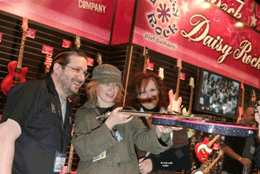 |
|
L-R: Ron Manus, Nancy Wilson (Heart), and Tish Ciravolo at Winter NAMM 2007. Photo by Brent Peters. |
Tish: We’ve got some really awesome guitars coming out, the Tom Boy Deuce, the Retro-H Deluxe. They’re sexy. I’m telling you, there are going to be some sexy things out this next year from us.
Tom: When you started, you were marketing mostly to younger girls, is that correct?
Tish: Right, and we still do the Hearts and the Butterflies. Last year we came out with Stars. I will always be that because that’s where I started. What’s really cool to me now is that I think I recognize in the teenagers and up that they’re looking for the traditional guitar body styles. They might consider some of the niche styles too young for them. So, we’re really concentrating on the professional side of our guitar models, that’s our dynamic and that’s why we’re going to win over the guitarists, because we’re a professional guitar company making traditional body styles for women.
Tom: What’s the toughest thing you’ve been up against since you started Daisy Rock?
Tish: I’m going to be PC on this one. One of the first challenges I had was leaving my husband’s company because I was very safe there. But, I had to take the leap. I had to do that for a lot of reasons. I had to keep the marriage good. It’s really hard to do the same thing that your husband does day in and day out and not have it rule your home life. We both recognized that and said, “Okay. You’ve got to get outside of Schecter if you’re going to grow Daisy Rock.”
That was my first challenge, to find a nurturing, positive, creative place to move to and I got that with Alfred. I felt very blessed by that. Meeting Ron Manus has been one of the most dynamic changes in my life – meeting someone who’s very business oriented, very creative, and knows a hell of a lot more about the business side of things than I ever have.
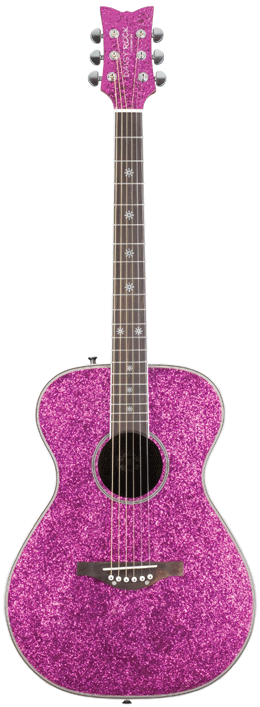 |
|
Pixie Acoustic with Pink Sparkle Finish |
Being a mother and running a company is not easy, people. I’m telling you. Everybody says, “Oh yes, it’s tough.” No, you don’t have any idea what tough means until you’re doing it. It’s like having a child. You don’t know how hard it is to have a child until you have one. Some people say, “Oh, having a child’s like having a dog. You just walk ’em and feed ’em.” Right. All you can say to them is, “No, no. It’s nothing like you’ve ever imagined it would be.” You never thought you could love something as much as you do your children. That’s how the guitar company is for me. It’s this thing I love so much that we have to conquer the world with it.
Tom: What underlies all of this is your desire to change an ideology.
Tish: Yes. Society’s thinking. The message has got to be on Fuse. It’s got to be on MTV. It’s got to be on VH1. It’s got to be Rockstar Supernova. It’s got to be on these things so people stop thinking, “Oh, she’s good, for a girl.” That’s got to go away. It’s just got to be erased from the world. That’s my hardest challenge. It’s convincing the world.
Tom: Has there been a moment in the Daisy Rock story where you almost gave up, where you thought “this is just too much”?
Tish: Yes, but I never would.
Tom: What were you up against when you almost said “this is enough”?
Tish: I think it was the first time I flew to Mars – to the store Mars in Florida – and I pitched Rick Powell. He was going to be my first big buyer. He was going to get the guitars into the Mars stores. It was all going to happen. We were going to sell $100,000 worth of guitars. Oh, my God. That was the biggest thing ever to me. Then he called me the next week and said, “I can’t issue the purchase order.” I said, “I’m ready. We’re pulling the trigger. I’m getting in touch with the factory. What do you mean you can’t? Why?” He said, “Because we’re going out of business.” It felt like somebody had just yanked that rug as hard as they could.
Tom: Brutal.
Tish: You get up, you dust yourself off, and you go after it again. There have been a few of those meetings where people say they’re going to do something. And, you know, I’m a nice person. I believe people. So, when they don’t do what they say they’re going to do that can get tough.
Tom: And the other side of the coin? What are a couple of the shining moments? I’m sure the museum induction was one.
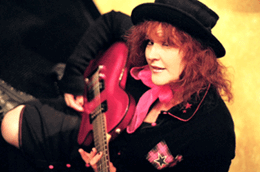 |
|
Tish Ciravolo |
Tish: The ultimate. The museum was the ultimate. But, the moments that make me cry, that get me all verklempt, are when I get letters from the girls. You know, “I’m eight-years-old. I started guitar and it changed my life.” And I get letters from the parents: “My daughter always wanted to learn how to play guitar. Thank God we found your site. We had no idea anybody cared.” We get a lot of those and it can so validate anything that I have to deal with during the day.
I got one recently that said, “Please let me be on your artist roster. I’m 13-years-old. I’m going to be the best guitar player in the world because I play a Daisy Rock.” Whether or not it ever happens for them doesn’t matter. It’s just the fact that they think they can because of something I started that blows my mind. I can’t tell you how much it blows my mind.
Tom: The “family photos” you have on your site are wonderful.
Tish: Those photos say it all. Everybody’s like, why do you do post those amateur customer snapshots? It’s because that’s what we do. We’re not Fender. We’re not Peavey. We’re not these other “look how professionally slick we are” companies. That’s not who I ever want to be. I want to be something different and I want it to count.
__
From the Daisy Rock Family Photo Album
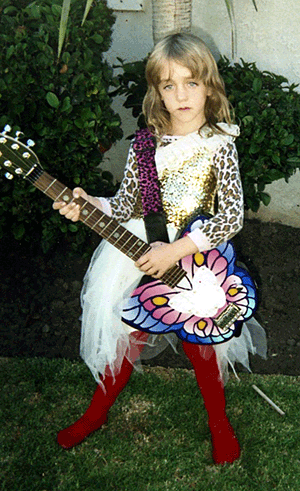
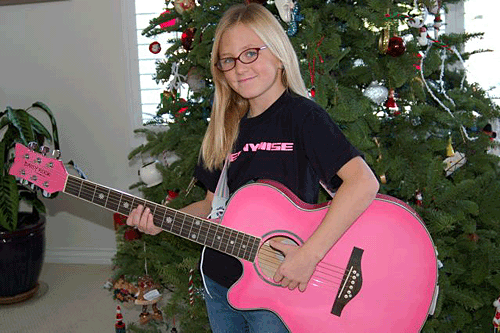

Related Links
Daisy Rock Guitars
Daisy Rock Family Photo Album
Women Rock! column by Tish Ciravolo
Photo Gallery: Daisy Rock Guitars at Winter NAMM 2007
Alfred Publishing
Shecter Guitar Research